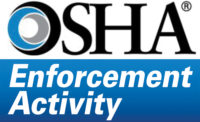The White House has designated this week as Extreme Heat Week. For federal agencies, it’s a time to double down on community preparedness for extreme heat events, with the help of community planners and public health officials.
For the National Institute for Occupational Safety and Health (NIOSH), it’s an opportunity to remind employers that hot weather is just ahead, and that workers who are exposed to extreme heat or work in hot environments may be at risk of heat stress, which can cause heat stroke, heat exhaustion, heat cramps, or heat rashes.
Heat can also increase the risk of injuries in workers as it may result in sweaty palms, fogged-up safety glasses, and dizziness. Burns may also occur as a result of accidental contact with hot surfaces or steam.
Who's at risk?
Workers at risk of heat stress include outdoor workers and workers in hot environments such as firefighters, bakery workers, farmers, construction workers, miners, boiler room workers, factory workers, and others. Those who are 65 years of age or older, are overweight, have heart disease or high blood pressure, or take certain medications are also at higher risk of heat stress.
How to prevent heat-related illness? Workers should be trained to understand what it is and how it can be prevented. That starts with being able to identify the symptoms:
Some heat-related illnesses
Heat stroke is the most serious heat-related illness. It occurs when the body becomes unable to control its temperature: the body's temperature rises rapidly, the sweating mechanism fails, and the body is unable to cool down. When heat stroke occurs, the body temperature can rise to 106°F or higher within 10 to 15 minutes. Heat stroke can cause death or permanent disability if emergency treatment is not given.
Symptoms of heat stroke include:
- Confusion, altered mental status, slurred speech
- Loss of consciousness (coma)
- Hot, dry skin or profuse sweating
- Seizures
- Very high body temperature
- Fatal if treatment delayed
First Aid
- Call 911
- Move the worker to a shaded, cool area and remove outer clothing.
- Cool the worker quickly with a cold water or ice bath if possible; wet the skin, place cold wet cloths on skin, or soak clothing with cool water.
- Place cold wet cloths or ice on head, neck, armpits, and groin; or soak the clothing with cool water.
Heat exhaustion is the body's response to an excessive loss of the water and salt, usually through excessive sweating. Workers most prone to heat exhaustion are those that are elderly, have high blood pressure, and those working in a hot environment.
Symptoms of heat exhaustion include:
- Headache
- Nausea
- Dizziness
- Weakness
- Irritability
- Thirst
- Heavy sweating
- Elevated body temperature
- Decreased urine output
First Aid
- Take worker to a clinic or emergency room for medical evaluation and treatment.
- If medical care is unavailable, call 911.
- Remove worker from hot area and give liquids to drink.
- Remove unnecessary clothing, including shoes and socks.
- Cool the worker with cold compresses or have the worker wash head, face, and neck with cold water.
- Encourage frequent sips of cool water.
Rhabdomyolysis is a medical condition associated with heat stress and prolonged physical exertion, resulting in the rapid breakdown, rupture, and death of muscle. When muscle tissue dies, electrolytes and large proteins are released into the bloodstream that can cause irregular heart rhythms and seizures, and damage the kidneys.
Symptoms of rhabdomyolysis include:
- Muscle cramps/pain
- Abnormally dark (tea or cola colored) urine
- Weakness
- Exercise intolerance
- Asymptomatic
- First Aid
- Stop activity.
- Increase oral hydration (water preferred).
- Seek immediate care at the nearest medical facility.
- Ask to be checked for rhabdomyolysis (i.e., blood sample analyzed for creatine kinase).
Click here for more information on heat-related illnesses.
Recommendations for Employers
Employers should take the following steps to protect workers from heat stress:
- Schedule maintenance and repair jobs in hot areas for cooler months.
- Schedule hot jobs for the cooler part of the day.
- Acclimatize workers by exposing them for progressively longer periods to hot work environments.
- Reduce the physical demands of workers.
- Use relief workers or assign extra workers for physically demanding jobs.
- Provide cool water or liquids to workers.
- Avoid alcohol, and drinks with large amounts of caffeine or sugar.
- Provide rest periods with water breaks.
- Provide cool areas for use during break periods.
- Monitor workers who are at risk of heat stress.
- Provide heat stress training that includes information about:
- Worker risk
- Prevention
- Symptoms
- The importance of monitoring yourself and coworkers for symptoms
- Treatment
- Personal protective equipment
Recommendations for Workers
- Workers should avoid exposure to extreme heat, sun exposure, and high humidity when possible. When these exposures cannot be avoided, workers should take the following steps to prevent heat stress:
- Wear light-colored, loose-fitting, breathable clothing such as cotton.
- Avoid non-breathing synthetic clothing.
- Gradually build up to heavy work.
- Schedule heavy work during the coolest parts of day.
- Take more breaks in extreme heat and humidity.
- Take breaks in the shade or a cool area when possible.
- Drink water frequently. Drink enough water that you never become thirsty. Approximately 1 cup every 15-20 minutes.
- Avoid alcohol, and drinks with large amounts of caffeine or sugar.
- Be aware that protective clothing or personal protective equipment may increase the risk of heat stress.
- Monitor your physical condition and that of your coworkers.




